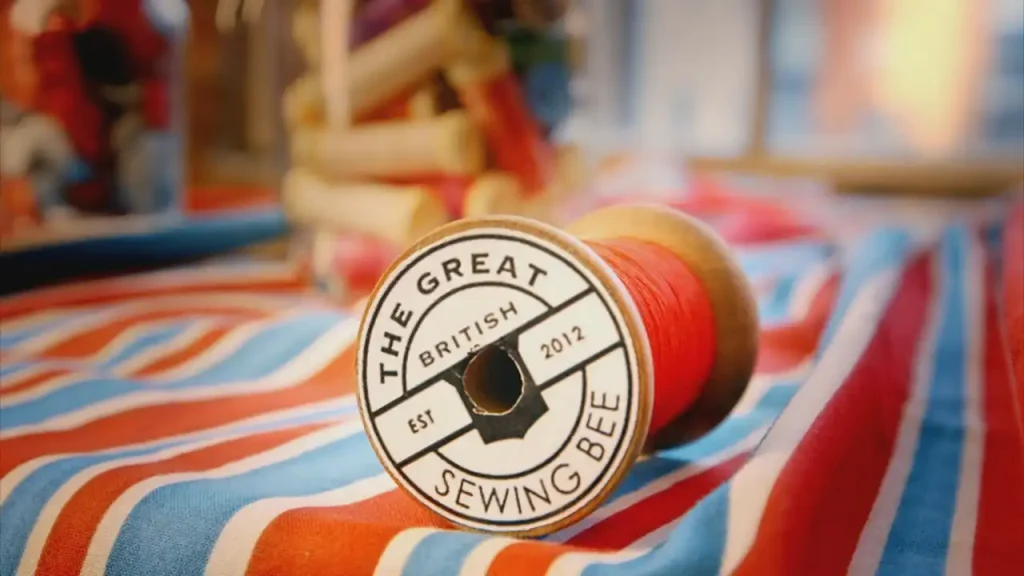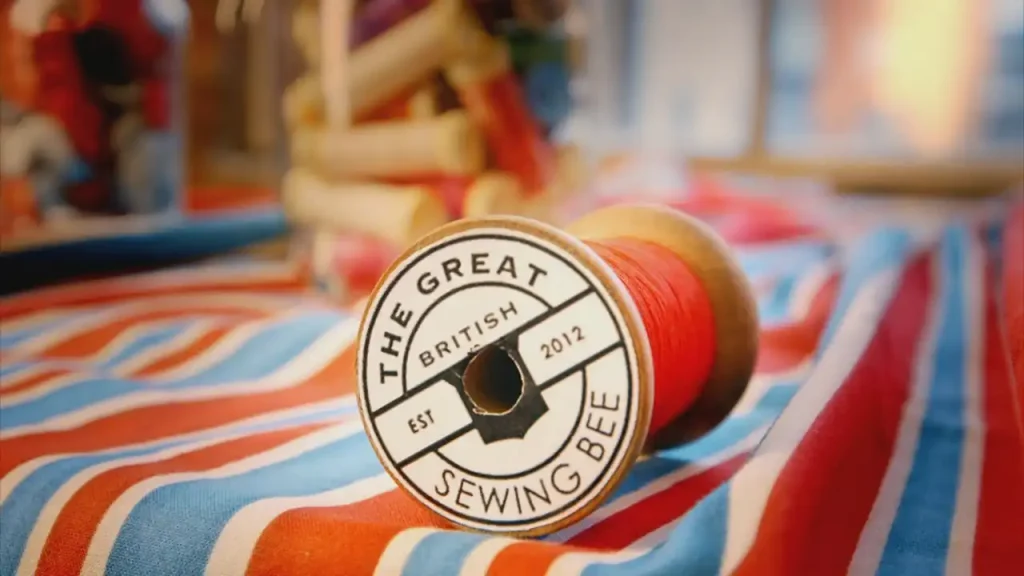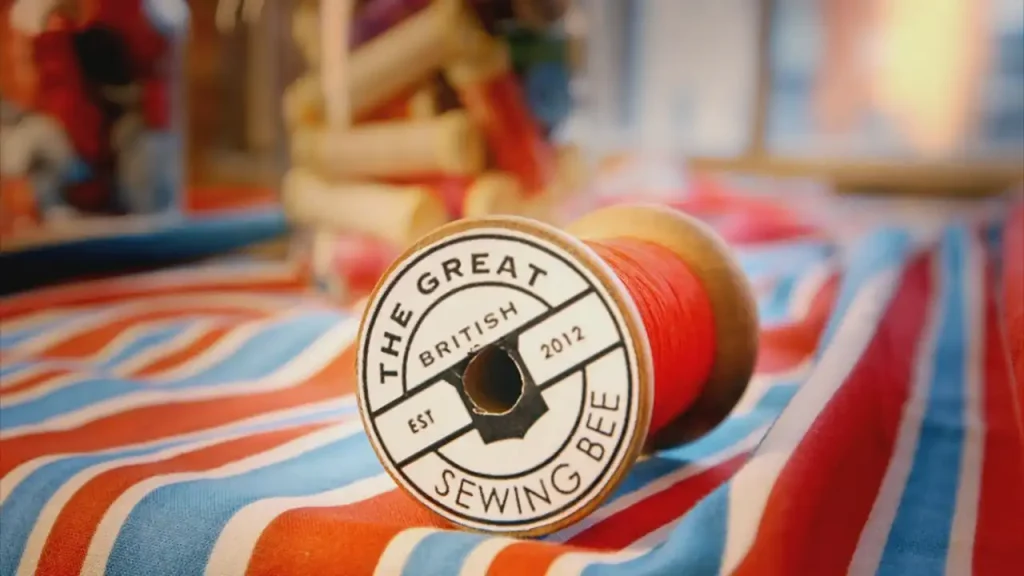The Great British Sewing Bee Season 2 Episode 8 – The atmosphere is electric as The Great British Sewing Bee gears up for its grand finale. The three remaining finalists make their way into the sewing room, a space that has become a second home over the past weeks, for one last showdown. The air is thick with anticipation and emotion as they prepare to showcase their final masterpieces. Standing between them and the coveted title of Britain’s Best Amateur Sewer are sewing guru May Martin and Patrick Grant, the esteemed tailor from Savile Row. Both judges are brimming with expertise, and they’ve designed three rigorously couture-themed challenges to test the mettle of these gifted sewers.
The first challenge is anything but ordinary. The finalists are presented with a curveball designed to test their hand-sewing finesse: the making of a man’s tie. Though it may sound simple on the surface, the stakes are heightened by the couture theme of the week. The judges aren’t just looking for a well-made tie; they’re expecting an embodiment of sartorial excellence. Each stitch must be impeccable, each line symmetrical, as the judges will settle for nothing less than perfection.
For the second challenge, the finalists are given a selection of wedding dresses to choose from, a sea of lace, silk, and tulle. Their task? To ingeniously transform their chosen gown into an enchanting child’s bridesmaid dress. This is an exercise in both skill and imagination as they’re required to maintain the intrinsic beauty of the original garment while resizing and restyling it for a much smaller frame.
The final assignment comes with an unexpected twist. The sewers must fit an exquisite, made-to-measure couture gown—but not for just any model. They are introduced to a model whose measurements they weren’t anticipating, adding another layer of complexity to an already challenging task. Precision and adaptability will be key as they make last-minute adjustments to ensure a flawless fit.
As the clock winds down, family, friends, and eliminated contestants start to gather in the sewing room. The room buzzes with a blend of nervous excitement and heartfelt pride as everyone assembles to witness the crowning moment. Only one will emerge victorious, earning the lifelong bragging rights of being declared the winner of The Great British Sewing Bee 2014.
Each stitch, each seam, and each buttonhole has led to this moment. So, who will thread the needle of destiny and sew their way into British crafting history? With the judges’ critical eyes, the weight of the title, and the sewing room filled with eager onlookers, all that’s left is to reveal who has truly measured up.
The Great British Sewing Bee Season 2 Episode 8: A Roller Coaster Ride to the Finals
The air was thick with tension in the sewing room as the final three contestants entered for the last time. They had battled through countless challenges over the past weeks, honing their skills and proving their merit. Now, it all came down to this – the final episode, where one would be crowned the winner of The Great British Sewing Bee 2014.
May Martin and Patrick Grant, with their keen eyes and wealth of experience, would decide who had what it takes to be named Britain’s best amateur sewer. The expectations were sky-high for this coveted title. As May said, with it being couture week, nothing short of absolute perfection would suffice.
The finalists steeled themselves for what promised to be three of the toughest challenges yet. Their journey so far had been a rollercoaster ride filled with highs and lows. Now, they had one last chance to demonstrate their creativity, precision, and mastery of technique.
A Surprise Pattern Test of Hand-Sewing Skills
The first bombshell was dropped when May and Patrick announced the pattern for the first challenge – the contestants would have to make a man’s tie! While it sounded straightforward, the stakes were high for this couture-level test. The smallest mistakes in sewing, pressing, and finishing would be glaringly obvious.
As May Martin remarked, “A simple tie may look easy to construct, but achieving a professional finish requires very neat hand-sewing skills.” Patrick Grant added that impeccable stitching, lining, and seam allowances were non-negotiable for couture. The contestants had to bring their A-game.
The surprise tie challenge tested not only their sewing proficiency but also their time management. With only a few hours to complete the tie from start to finish, they had to work swiftly without compromising on finesse. Some of the key points the judges would be scrutinizing included:
- Hand-stitched full lining with no puckering
- Clean curves when joining the body to the wide end of the tie
- Neat stitching and seam finishing on the inner tips
- Precision topstitching and edge stitching
- A crisp knot and dimple when tied
As the clock ticked down, the sewers demonstrated immense focus, skill, and attention to detail. For most, hand-sewing the lining was the trickiest part. Some ended up having to unpick and redo stitching multiple times to attain the polished finish May and Patrick expected.
It was clear the judges were not exaggerating when they emphasized the need for couture-level execution. The contestants realized no minuscule flaw would go unnoticed. This first challenge set the tone – only the most masterful and consistent sewer had a chance of taking home the trophy.
The Made-to-Measure Child’s Bridesmaid Dress Challenge
A collective gasp echoed through the sewing room when the details of the second challenge were revealed. May and Patrick presented the finalists with a rack of wedding dresses and announced they would have to alter one into a child’s bridesmaid dress fit for couture week!
The judges allowed the sewers to select which dress to work with. However, each design had its own complexities. As Patrick noted, “Choosing the right dress and figuring out how to rework it for a child’s proportions is key.” Some of the key factors the contestants had to consider included:
- Translating adult design features into child-appropriate style
- Adjusting bodice, waist, hips, and length for perfect fit
- Handling delicate fabrics and trims
- Retaining structural integrity when altering construction
- Achieving a high degree of finish with linings, hems, zippers, and more
With the clock counting down, the sewers had to navigate these challenges while also demonstrating technical mastery. May emphasized that a poorly constructed dress could not be masked under decorative frills. Patrick added that an imprecise fit would be unacceptable for couture.
Once again, achieving the needed fit within the time constraint proved demanding. The contestants had to employ all their alteration and finishing skills. However, the most successful were those who put together a meticulous plan from the start. They carefully chose a style they could re-fashion effectively.
The judges did allow some leniency with fit at the child’s waist and bust. But perfect finishing to lend a luxurious, couture aesthetic was non-negotiable. Only the most skillful and strategic sewer succeeded in walking the fine line between technical precision and style.
The Pressure Cooker Finale – A Surprise Couture Gown Fit
The final challenge was the culmination of everything the sewers had learned and honed over the past weeks – their ultimate test. May and Patrick surprised them with a showstopping couture gown that had to be fitted perfectly on a model they had never sewn for before.
To replicate the demands of real-world couture, the model’s measurements were only provided halfway through the challenge. The sewers had to pin-fit the gown from scratch before completing the final construction.
As May remarked, “Fitting couture on a model requires extreme precision and finesse to achieve the highest standard demanded by this elite category.” Patrick added that there was zero margin for error – the gown had to fit like a glove and move flawlessly with the model.
Working under intense time pressure, the sewers had to employ all their skill in:
- Careful fabric manipulation to create impeccable drape
- Precise cutting, trimming, and piecing to perfect the fit
- Hand-stitched alterations with no visible signs of tweaking
- Meticulous pressing to accentuate the luxury fabrics
- Structured linings and underpinnings for silhouette and support
- Exquisite attention to detail with finishing, hems, and embellishments
The final runway presentation was the ultimate reveal. The sewers watched anxiously as the models displayed their work in all its glory. The judges went over every gown minutely, seeking not a single misstep in design, construction, or fit. For the contestants, it was a tense moment of truth to see whether their work measured up to the exacting couture standard.
The Winner Is Crowned
As Patrick Grant remarked, “Today you have sewn at the highest level of finesse, precision, and attention to detail. But there can only be one winner.”
The final judging left no room for doubt. One sewer stood out as the most skillful, consistent, and commanding over the series of grueling challenges. Their work was superlative in technique, construction, fit, and finish. They impressed May and Patrick by responding so brilliantly under intense pressure.
When the winner was announced, the sewing room erupted in rapturous applause and cheers. At the same time, the thrill of victory was tinged with sadness over the competition ending. The finalists tearfully hugged their fellow contestants, reminiscing over the indelible memories made together.
Though only one took home the trophy, they had all pushed their skills and creativity to unfamiliar heights. Over 9 weeks and through 30 challenges, the sewers were proud of their tenacity and growth. They would take home far more than finished garments – but life-long passions, knowledge, and friendships.
As May Martin said, the show succeeded in its mission of inspiring a new generation to take up sewing. Above the title, the bigger prize was discovering the immense joy and sense of fulfillment that came from working with fabric and thread. That feeling would continue motivating and enriching the contestants long after the cameras stopped rolling.
5 Key Takeaways from The Great British Sewing Bee Journey
The Great British Sewing Bee was an enriching experience both for the contestants and viewers. Here are 5 main lessons that emerged over the course of the competition:
1. Sewing requires a blend of creativity and technical mastery – The best sewers not only have great technique but also an artistic eye for design. Knowing how to handle varied fabrics and garment types is vital.
2. Meticulous planning is crucial – From reading patterns to managing time, organized project workflow prevents mistakes. Thorough preparation is key to perfect execution.
3. Attention to detail makes all the difference – Finished garments must have impeccable fit, construction, pressing, hems, closures and more. The couture-level finesse comes from care over every minuscule element.
4. Consistency under pressure is paramount – The ability to repeatedly deliver excellent work despite grueling time constraints and high expectations is what sets the winners apart.
5. Passion shines through in the end result – Most of all, sewing excellence requires immense commitment, patience, enthusiasm and love for the craft. The joy of creation translates into exquisite work.
Frequently Asked Questions
What are May Martin’s signature style elements?
May Martin is renowned for her impeccable attention to detail, insistence on perfection, and mastery of technique. Her style combines classic, elegant silhouettes with couture construction and hand finishes. She favors natural fabrics like silks, wools, and linens.
How can you sew a man’s tie at home?
Sewing a quality necktie at home requires patience, precision, and hand-finishing skills. Key steps include cutting fabric on the bias, handling tricky angles, sewing full linings, topstitching, and hand-rolling and stitching the edges. Using specialty interfacing, lining fabrics, and equipment helps achieve professional results.
What fabrics work best for a child’s bridesmaid dress?
When choosing fabric for a child’s bridesmaid dress, prioritize soft, comfortable materials with a nice drape like chiffon, charmeuse, or crepe. Avoid anything too thick or structured. Consider lining the dress in a smooth fabric to prevent irritation. Rayon, polyester, cotton blends are often suitable.
How can you make alterations to a wedding dress non-destructive?
To alter a wedding gown non-destructively, avoid cutting into the original seams wherever possible. Carefully remove stitching to open seams and recut panels from the inside or use piecing to preserve outer fabric. For taking in, fold excess into darts rather than trimming away. Use hand-stitching instead of machine sewing.
What are the essential steps in couture gown pattern drafting and construction?
Couture gown pattern drafting involves draping fabric on a form to develop the panels. The meticulously fitted muslin prototype serves as the basis for the final. Hand-finishing and structural underpinnings lend shape and drape. Couture construction relies on precise pressing, sewing, detail work, and modifications during fittings.
Conclusion
The Great British Sewing Bee reminded us of the immense dedication and artistry involved in elevating sewing to the level of couture. We witnessed the contestants’ passion and growth over a intensely competitive yet hugely rewarding journey.
The show highlighted that a blend of creative vision, technical excellence and attention to detail is needed to produce garments of exceptional beauty, quality and finesse. Though only one took home the prize, all the sewers were enriched by testing their skills and honing their craft.
The Great British Sewing Bee succeeded in its goal of igniting enthusiasm and awakening talent for sewing’s possibilities. Whether or not we pursue sewing professionally, we can all find fulfillment in using thread and fabric to turn imagination into tangible creation. When we apply skill, patience, and joy to the art of clothing construction, we produce not just garments, but also confidence, resilience and a sense of pride.




